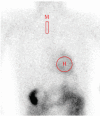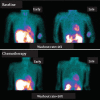Evaluation of Cardiac Mitochondrial Function by a Nuclear Imaging Technique using Technetium-99m-MIBI Uptake Kinetics
- PMID: 27408841
- PMCID: PMC4937671
- DOI: 10.7508/aojnmb.2013.01.008
Evaluation of Cardiac Mitochondrial Function by a Nuclear Imaging Technique using Technetium-99m-MIBI Uptake Kinetics
Abstract
Mitochondria play an important role in energy production for the cell. The proper function of a myocardial cell largely depends on the functional capacity of the mitochondria. Therefore it is necessary to establish a novel and reliable method for a non-invasive assessment of mitochondrial function and metabolism in humans. Although originally designed for evaluating myocardial perfusion, (99m)Tc-MIBI can be also used to evaluate cardiac mitochondrial function. In a clinical study on ischemic heart disease, reverse redistribution of (99m)Tc-MIBI was evident after direct percutaneous transluminal coronary angioplasty. The presence of increased washout of (99m)Tc-MIBI was associated with the infarct-related artery and preserved left ventricular function. In non-ischemic cardiomyopathy, an increased washout rate of (99m)Tc-MIBI, which correlated inversely with left ventricular ejection fraction, was observed in patients with congestive heart failure. Increased (99m)Tc-MIBI washout was also observed in mitochondrial myopathy, encephalopathy, lactic acidosis and stroke-like episodes (MELAS) and in doxorubicin-induced cardiomyopathy. Noninvasive assessment of cardiac mitochondrial function could be greatly beneficial in monitoring possible cardiotoxic drug use and in the evaluation of cardiac damage in clinical medicine.
Keywords: 99mTc-MIBI; cardiomyopathy; heart failure; ischemic heart disease; mitochondria.
Figures




Similar articles
-
The Utility of a Combination of 99mTc-MIBI Washout Imaging and Cardiac Magnetic Resonance Imaging in the Evaluation of Cardiomyopathy.Ann Nucl Cardiol. 2021;7(1):8-16. doi: 10.17996/anc.21-00124. Epub 2021 Aug 31. Ann Nucl Cardiol. 2021. PMID: 36994134 Free PMC article.
-
Cardiac scintigraphic findings of mitochondrial myopathy, encephalopathy, lactic acidosis and stroke-like episodes: A case report.Exp Clin Cardiol. 2008 Summer;13(2):93-5. Exp Clin Cardiol. 2008. PMID: 19343124 Free PMC article.
-
A novel clinical indicator using Tc-99m sestamibi for evaluating cardiac mitochondrial function in patients with cardiomyopathies.J Nucl Cardiol. 2007 Apr;14(2):215-20. doi: 10.1016/j.nuclcard.2006.10.022. J Nucl Cardiol. 2007. PMID: 17386384
-
Analysis of Cardiac Metabolic Remodeling in Heart Failure Using Nuclear Medicine and Its Application: Japanese Society of Nuclear Cardiology Award.Ann Nucl Cardiol. 2020;6(1):91-94. doi: 10.17996/anc.20-00112. Epub 2020 Aug 31. Ann Nucl Cardiol. 2020. PMID: 37123491 Free PMC article. Review.
-
Clinical Implications of the Washout Phenomenon in Technetium-99m (99mTc-) Labeled Compounds for Myocardial Perfusion Imaging.Ann Nucl Cardiol. 2024;10(1):55-58. doi: 10.17996/anc.24-00010. Epub 2024 Oct 31. Ann Nucl Cardiol. 2024. PMID: 39635330 Free PMC article. Review.
Cited by
-
Mathematical Simulation of Transport Kinetics of Tumor-Imaging Radiopharmaceutical 99mTc-MIBI.Comput Math Methods Med. 2017;2017:2414878. doi: 10.1155/2017/2414878. Epub 2017 Jun 15. Comput Math Methods Med. 2017. PMID: 28702073 Free PMC article.
-
The Utility of a Combination of 99mTc-MIBI Washout Imaging and Cardiac Magnetic Resonance Imaging in the Evaluation of Cardiomyopathy.Ann Nucl Cardiol. 2021;7(1):8-16. doi: 10.17996/anc.21-00124. Epub 2021 Aug 31. Ann Nucl Cardiol. 2021. PMID: 36994134 Free PMC article.
-
Deep learned triple-tracer multiplexed PET myocardial image separation.Front Nucl Med. 2024 Apr 11;4:1379647. doi: 10.3389/fnume.2024.1379647. eCollection 2024. Front Nucl Med. 2024. PMID: 39381030 Free PMC article.
References
-
- Finck BN, Kelly DP. Peroxisome proliferator-activated receptor gamma coactivator-1 (PGC-1) regulatory cascade in cardiac physiology and disease. Circulation. 2007;115(19):2540–8. - PubMed
-
- Backus M, Piwnica-Worms D, Hockett D, Kronauge J, Lieberman M, Ingram P, LeFurgey A. Microprobe analysis of Tc-MIBI in heart cells: calculation of mitochondrial membrane potential. Am J Physiol. 1993;265(1 Pt 1):C178–87. - PubMed
-
- Piwnica-Worms D, Kronauge JF, Chiu ML. Enhancement by tetraphenylborate of technetium-99m-MIBI uptake kinetics and accumulation in cultured chick myocardial cells. J Nucl Med. 1991;32(10):1992–9. - PubMed
-
- Kostakoglu L, Kiratli P, Ruacan S, Hayran M, Emri S, Ergün EL, Bekdik CF. Association of tumor washout rates and accumulation of technetium-99m-MIBI with expression of P-glycoprotein in lung cancer. J Nucl Med. 1998;39(2):228–34. - PubMed
Publication types
LinkOut - more resources
Full Text Sources
